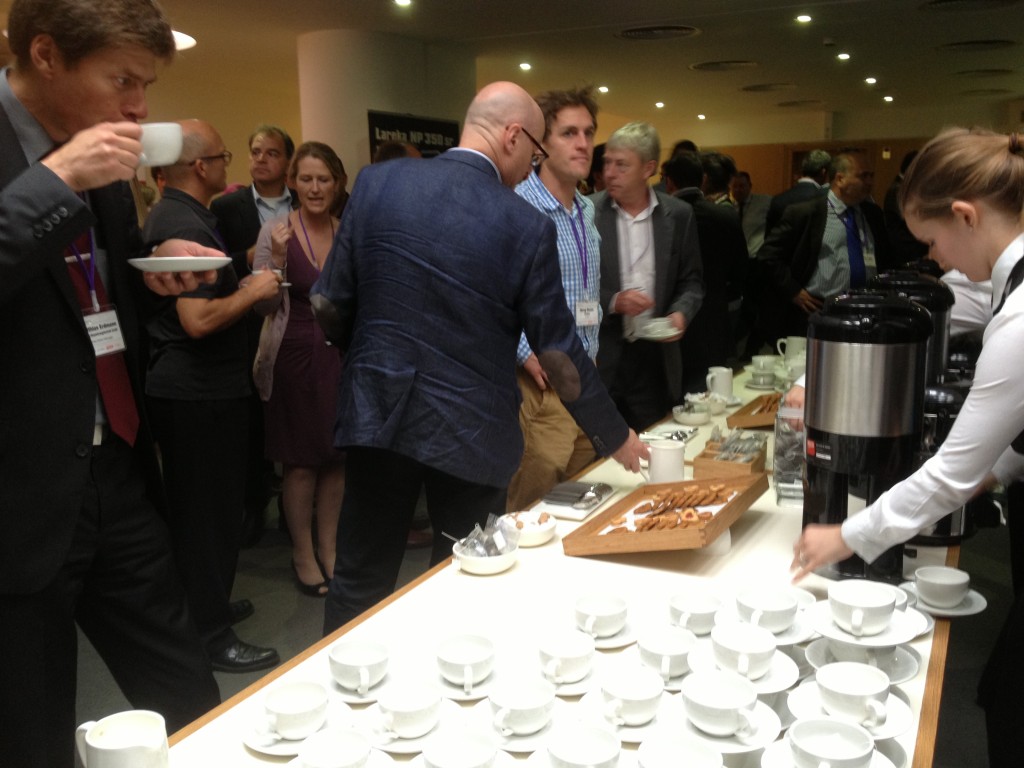“It’s just lovely,” says Richard Reilly, Managing Director of Kinnerton Confectionary. Everyone knows everyone, and people tend to help out where they can. Around Easter sometimes we make eggs for each other.”
I nod through a mouthful of rum and raisin ganache truffle. We’re standing in the British Library, a venue aptly ripe with imagination and invention for the Chocolate Industry Network, where manufacturers, innovators and gluttons gather annually to discuss their dearest subject. There are tables covered in samples, chocolate moulds, chocolate history, chocolate everything. “You should come see the chocolates being made in the Norfolk factory. It’s beautiful,” adds Richard. Willy Wonka might dance off the shelves at any moment.
Not all industries are nice. Fashion is notoriously bitchy. Finance is stressful.
But the business of making chocolate seems rather sweet. Richard is keen to stress this point, enthusing: “Everyone knows about the main producers of course. But there’s camaraderie among the lesser-known chocolate makers. We’ll happily make things for one another here and there. Co-operation is good, it’s all about trade.”
And so riding our sugar high, we network away. The day consists of a mixture of lectures, discussions, and general chat over the good stuff. Refreshing lemon drinks are on offer for those who have had a little too much. I learn about the always-encouraging health advantages from Leen Allegaert, an innovation manager in clinical research. Apparently just 10 grams of high-cocoa chocolate provides beneficial flavanol, an antioxidant which helps to maintain the elasticity of blood vessels. This contributes to normal blood flow and general cardiovascular health. “And that amount only contains 55 calories. It’s pretty reasonable,” adds Leen. It occurred to me that I must already have consumed enough chocolate during the day to reap the delightful effects of flavanol many, many times over.
 There are inspirational stories brewed in the conches of chocolate factories all over the world. Heikel Ethel, owner and manager of the Lebanese company Ethel Chocolates, describes his embryonic creations when he set out to form a business in the early nineties: “I clumsily sandwiched biscuits – I bought bags of all kinds that I could lay my hands on- with chocolate for the children in the local villages around the Bekaa Valley.” Heikel was quick to respond to sweet-toothed demand, and his business grew swiftly. He bought a building, machinery, and took his brother on as sales manager. Two decades later what began as a one-man show is now one of the most well-regarded luxury chocolate brands in the world, operating out of 160,000 square metres of factory space. I sample several of his elegantly-packaged wares, they are refined and delicious.
There are inspirational stories brewed in the conches of chocolate factories all over the world. Heikel Ethel, owner and manager of the Lebanese company Ethel Chocolates, describes his embryonic creations when he set out to form a business in the early nineties: “I clumsily sandwiched biscuits – I bought bags of all kinds that I could lay my hands on- with chocolate for the children in the local villages around the Bekaa Valley.” Heikel was quick to respond to sweet-toothed demand, and his business grew swiftly. He bought a building, machinery, and took his brother on as sales manager. Two decades later what began as a one-man show is now one of the most well-regarded luxury chocolate brands in the world, operating out of 160,000 square metres of factory space. I sample several of his elegantly-packaged wares, they are refined and delicious.
There are still constant challenges, ones particular to operating within a turbulent environment. Ethel describes his approach as “The Lebanese reaction to a tough time.” Things change quickly, and he adapts. “Fuel and electricity are expensive at the moment. But we still train every employee how to wrap chocolates perfectly.” He stresses that Lebanon is an “open market country”. Saudi Arabia and Kuwait are the biggest buyers of his chocolates in the Middle East.
On the other side of the coin is Charbonnel et Walker, who have sold chocolates since 1875 out of their flagship store on Old Bond Street. Peter Irvine, Director of UK Sales and Export was adamant that even despite cruelly high rent, they would never change their location “to say, Regent Street”. Tradition is everything, even among employees. “Our average experience level on the core team is 25 years,” he added.
And Charbonnel have – gradually, carefully, made some headway towards attracting a younger market. Their ‘handbags and heels’ range of shaped chocolates shifts 250,000 units per year, and their target demographic is no longer the over-sixties. Women between 35 and 50 are now Charbonnel’s most devout consumers – though their pink champagne truffle sets hearts racing across the board. Charbonnel remain suspicious of new trends. Peter sniffs that while introducing a sea salt flavour was a “brave but unavoidable risk”, you’ll “never see us start to use chilli. It’s not for us, and others do it better.” They ought to know what works. Charbonnel sell chocolate at a breathtaking £75 per kilo, a staggering margin beyond any other company present today.
Chocolate is addictive. Once they enter the chocolate world, people tend to stick around. “It’s a good place to be,” muses Richard Reilly. “One thing I would emphasise is the importance of ethics, though. People get very hung up on the idea of organic. But the thing is, that’s all just a question of certification. Cocoa is grown in places that are organic by their very definition. If you’re willing to pay a little extra for chocolate, spend it on fair trade. Make sure people are paid fairly.”


